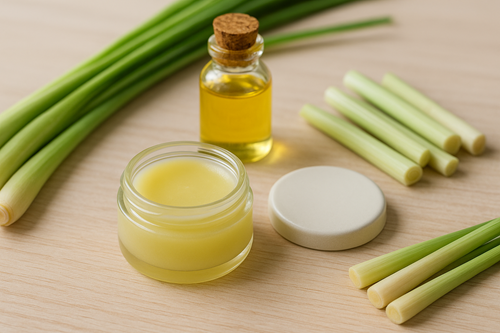Lemongrass oil-based aromatherapy balm innovation for muscle pain reduction and body relaxation
Abstract
Introduction: Muscle pain is a common condition that affects individuals of various ages due to physical strain, fatigue, or improper posture. Conventional balms often rely on synthetic chemical agents that may cause irritation or excessive heat sensation. Therefore, developing a natural-based topical formulation with dual functions pain reduction and body relaxation has gained growing attention. Lemongrass oil (Cymbopogon citratus) contains active compounds such as citral, geraniol, and limonene, known for their analgesic, anti-inflammatory, and aromatherapeutic properties. This study aimed to innovate an aromatherapy balm using lemongrass essential oil to provide both pain relief and a relaxing effect on the body.
Methods: This experimental laboratory study employed a post-test-only design. The balm was formulated with varying concentrations of lemongrass oil (5%, 10%, and 15%), beeswax, vaseline, coconut oil, and menthol. The formulations underwent organoleptic evaluation, skin irritation testing, and effectiveness assessment on mild muscle pain using the Visual Analog Scale (VAS). Ten respondents with muscle discomfort applied the balm twice daily for three days. Data were analyzed descriptively to compare the physical stability, acceptability, and pain reduction effectiveness of each concentration.
Results: All formulations demonstrated good physical stability, showing no color or odor alteration after 14 days of storage. Organoleptic evaluation revealed that the 10% lemongrass oil concentration was the most preferred, exhibiting a pleasant aroma and smooth texture. Effectiveness testing indicated that the 10% balm reduced pain intensity by an average of 40%, outperforming the 5% (25%) and 15% (38%) formulations. No cases of skin irritation were reported. Respondents also reported a sense of calmness and relaxation attributed to the aromatherapeutic properties of lemongrass.
Conclusion: The aromatherapy balm containing 10% lemongrass oil provides optimal pain relief and relaxation effects without adverse skin reactions. This innovation offers a promising alternative to conventional synthetic balms, aligning with the growing demand for safe, natural, and eco-friendly complementary therapies.
Downloads
References
Adeyemi, S. B. et al. (2023) ‘Polymeric nanoparticles for enhanced delivery and improved bioactivity of essential oils’, Heliyon, 9(6), p. e16543. doi: https://doi.org/10.1016/j.heliyon.2023.e16543.
Al-Rawi, S. S. et al. (2024) ‘Therapeutic, and pharmacological prospects of nutmeg seed: A comprehensive review for novel drug potential insights’, Saudi Pharmaceutical Journal, 32(6), p. 102067. doi: https://doi.org/10.1016/j.jsps.2024.102067.
Alimoradi, Z. et al. (2023) ‘Therapeutic applications of lemon balm (Melissa officinalis) for obstetrics and gynecological health issues: A systematic review’, Journal of Herbal Medicine, 42, p. 100751. doi: https://doi.org/10.1016/j.hermed.2023.100751.
Arai, T. et al. (2024) ‘The association between interoception and olfactory affective responses’, Biological Psychology, 193, p. 108878. doi: https://doi.org/10.1016/j.biopsycho.2024.108878.
Asnita, A. et al. (2023) ‘Lavender And Lemon Aromatherapy Against Anxiety III Trimester Pregnant Women Facing Labor’, Jurnal Ilmiah Kesehatan Sandi Husada, 12(2), pp. 376–382. doi: https://dx.doi.org/10.35816/jiskh.v12i2.1098.
Can, S., Gezginci, E. and Yapici, N. (2023) ‘Effect of menthol lozenges after extubation on thirst, nausea, physiological parameters, and comfort in cardiovascular surgery patients: A randomized controlled trial’, Intensive and Critical Care Nursing, 76, p. 103415. doi: https://doi.org/10.1016/j.iccn.2023.103415.
Devi, L. S. et al. (2024) ‘Essential oils as functional agents in biopolymer-based sustainable food packaging system: A review’, Sustainable Chemistry and Pharmacy, 39, p. 101563. doi: https://doi.org/10.1016/j.scp.2024.101563.
Elvir Lazo, O. L. et al. (2024) ‘Use of herbal medication in the perioperative period: Potential adverse drug interactions’, Journal of Clinical Anesthesia, 95, p. 111473. doi: https://doi.org/10.1016/j.jclinane.2024.111473.
Khalid, S. et al. (2024) ‘Recent advances in the implementation of ultrasound technology for the extraction of essential oils from terrestrial plant materials: A comprehensive review’, Ultrasonics Sonochemistry, 107, p. 106914. doi: https://doi.org/10.1016/j.ultsonch.2024.106914.
Kimura, R., Schwartz, J. and Bennett-Guerrero, E. (2023) ‘A narrative review on the potential therapeutic benefits of chamomile in the acute care setting’, Journal of Herbal Medicine, 41, p. 100714. doi: https://doi.org/10.1016/j.hermed.2023.100714.
Koparal, M. and Ege, M. (2023) ‘Dietary supplements used by otolaryngology patients in Turkey during the COVID-19 pandemic: A cross-sectional survey’, European Journal of Integrative Medicine, 60, p. 102249. doi: https://doi.org/10.1016/j.eujim.2023.102249.
Korczak, M. et al. (2023) ‘Phytotherapy of mood disorders in the light of microbiota-gut-brain axis.’, Phytomedicine, 111, p. 154642. doi: https://doi.org/10.1016/j.phymed.2023.154642.
Kwon, C.-Y. and Lee, B. (2023) ‘Complementary and integrative medicines for behavioral and psychological symptoms of dementia: Overview of systematic reviews’, EXPLORE, 19(2), pp. 176–194. doi: https://doi.org/10.1016/j.explore.2022.08.005.
Liu, L. et al. (2024) ‘The effect of aromatherapy on patients with acute coronary syndrome: A systematic review and meta-analysis’, Complementary Therapies in Clinical Practice, 57, p. 101882. doi: https://doi.org/10.1016/j.ctcp.2024.101882.
Mohammed, H. A. et al. (2024) ‘Essential oils pharmacological activity: Chemical markers, biogenesis, plant sources, and commercial products’, Process Biochemistry, 144, pp. 112–132. doi: https://doi.org/10.1016/j.procbio.2024.05.021.
Mulugeta, S. M., Sárosi, S. and Radácsi, P. (2023) ‘Physio-morphological trait and bioactive constituents of Ocimum species under drought stress’, Industrial Crops and Products, 205, p. 117545. doi: https://doi.org/10.1016/j.indcrop.2023.117545.
Nath, P. C. et al. (2024) ‘Essential oils and their critical implications in human use’, Biocatalysis and Agricultural Biotechnology, 60, p. 103258. doi: https://doi.org/10.1016/j.bcab.2024.103258.
Pei, S. et al. (2024) ‘Exploring the physiological response differences of β-caryophyllene, linalool and citral inhalation and their anxiolytic potential’, Heliyon, 10(19), p. e38941. doi: https://doi.org/10.1016/j.heliyon.2024.e38941.
Rostaei, M. et al. (2024) ‘Organic manures enhance biomass and improve content, chemical compounds of essential oil and antioxidant capacity of medicinal plants: A review’, Heliyon, 10(17), p. e36693. doi: https://doi.org/10.1016/j.heliyon.2024.e36693.
Salsabilla, A. (2020) ‘Lavender Aromatherapy for Reducing Anxiety Level of Labor’, Jurnal Ilmiah Kesehatan Sandi Husada, 9(2 SE-Articles). doi: https://dx.doi.org/10.35816/jiskh.v12i2.407.
Shamabadi, A. et al. (2023) ‘The anxiolytic effects of Lavandula angustifolia (lavender): An overview of systematic reviews’, Journal of Herbal Medicine, 40, p. 100672. doi: https://doi.org/10.1016/j.hermed.2023.100672.
Silva Júnior, A. Q. et al. (2024) ‘Molecular modelling and anticholinesterase activity of the essential oil from three chemotypes of Lippia alba (Mill.) N.E.Br. ex Britton & P. Wilson (Verbenaceae)’, Heliyon, 10(8), p. e29063. doi: https://doi.org/10.1016/j.heliyon.2024.e29063.
Sinaei, M. et al. (2024) ‘The Effect of Inhalation Aromatherapy with Lemon Balm (Melissa officinalis) Essential Oil on Sleep Quality in Mothers of Preterm Infants in the Neonatal Intensive Care Unit (A Randomized Clinical Trial Study)’, The Open Public Health Journal, 17. doi: https://doi.org/10.2174/0118749445280519240110075936.
Singh, S. et al. (2024) ‘Aromatic crops cultivation a promising option in Indian agricultural system to support circular economy: A sustainable approach’, Sustainable Chemistry and Pharmacy, 42, p. 101863. doi: https://doi.org/10.1016/j.scp.2024.101863.
Suprapto et al. (2024) ‘Building Nurse Competency Strategy at Public Health Center in Indonesia: A Descriptive Qualitative Approach’, The Malaysian Journal of Nursing, 15(03), pp. 62–70. doi: https://dx.doi.org/10.31674/mjn.2024.v15i03.008.
Syaharuddin, S. et al. (2024) ‘Public health nurses’ caring behaviour can increase homecare patients’ satisfaction’, Jurnal Ilmiah Kesehatan Sandi Husada, 13(2), pp. 214–222. doi: https://doi.org/10.35816/jiskh.v13i2.1207.
Tan, J. X. J., Cai, J. S. and Ignacio, J. (2023) ‘Effectiveness of aromatherapy on anxiety and sleep quality among adult patients admitted into intensive care units: A systematic review’, Intensive and Critical Care Nursing, 76, p. 103396. doi: https://doi.org/10.1016/j.iccn.2023.103396.
Ting, Y.-Y., Tien, Y. and Huang, H.-P. (2023) ‘Effects of aromatherapy on agitation in patients with dementia in the community: A quasi-experimental study’, Geriatric Nursing, 51, pp. 422–428. doi: https://doi.org/10.1016/j.gerinurse.2023.04.010.
Wang, P.-H. et al. (2024) ‘Efficacy of Aromatherapy Against Behavioral and Psychological Disturbances in People With Dementia: A Meta-Analysis of Randomized Controlled Trials’, Journal of the American Medical Directors Association, 25(11), p. 105199. doi: https://doi.org/10.1016/j.jamda.2024.105199.

Copyright (c) 2025 Yuniharce Kadang, Gerfan Patandung

This work is licensed under a Creative Commons Attribution 4.0 International License.




2.png)
1.png)
1.png)










